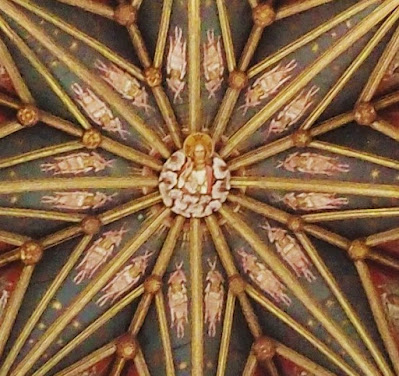 |
| Detail of picture above: John of Burwell’s carving of Christ in Majesty, in the place it has occupied since 1340. |
Sunday, February 13, 2022
Seven Hundred Years Ago Today
Sunday, February 06, 2022
God Save the Queen
A message from Her Majesty the Queen on the seventieth anniversary of her accession to the throne. Amid its characteristic understatement are certain poignant details; I am particularly moved by the beginning of the final paragraph.
Thank God for our Queen.
Tomorrow, 6th February, marks the 70th anniversary of my Accession in 1952. It is a day that, even after 70 years, I still remember as much for the death of my father, King George VI, as for the start of my reign.
As we mark this anniversary, it gives me pleasure to renew to you the pledge I gave in 1947 that my life will always be devoted to your service.
As I look ahead with a sense of hope and optimism to the year of my Platinum Jubilee, I am reminded of how much we can be thankful for. These last seven decades have seen extraordinary progress socially, technologically and culturally that have benefitted us all; and I am confident that the future will offer similar opportunities to us and especially to the younger generations in the United Kingdom and throughout the Commonwealth.
I am fortunate to have had the steadfast and loving support of my family.
I was blessed that in Prince Philip I had a partner willing to carry out the role of consort and unselfishly make the sacrifices that go with it. It is a role I saw my own mother perform during my father’s reign.
This anniversary also affords me a time to reflect on the goodwill shown to me by people of all nationalities, faiths and ages in this country and around the world over these years. I would like to express my thanks to you all for your support. I remain eternally grateful for, and humbled by, the loyalty and affection that you continue to give me. And when, in the fullness of time, my son Charles becomes King, I know you will give him and his wife Camilla the same support that you have given me; and it is my sincere wish that, when that time comes, Camilla will be known as Queen Consort as she continues her own loyal service.
And so as I look forward to continuing to serve you with all my heart, I hope this Jubilee will bring together families and friends, neighbours and communities – after some difficult times for so many of us – in order to enjoy the celebrations and to reflect on the positive developments in our day-to-day lives that have so happily coincided with my reign.
Retrieved from https://www.royal.uk/queens-accession-day-message
I do not myself think that there has been overall social or cultural improvement in Britain over the course of our present Queen’s reign, but that is no fault of hers: it is we who have failed in following her example. But her words here show that in spite of that, without bitterness, she is thinking foremost of our unity in the years ahead.




